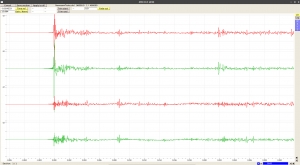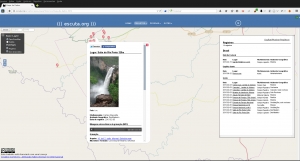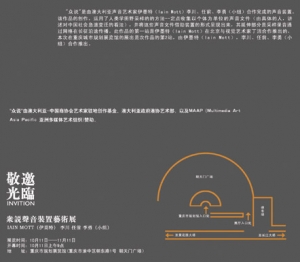
Iain Mott
Iain Mott is a sound artist, living in Brazil since 2007. He was a visiting professor in the Music Department at the University of Brasilia (UnB) from 2008 to 2011 and a lecturer (professor adjunto) in the area of voice and sound design in the Departamento de Artes Cênicas (theatre arts), UnB from 2012-2024. His sound installations are characterised by high levels of audience participation and novel approaches to interactivity. He has exhibited widely in Australia and at shows including the Ars Electronica Festival in Linz, Emoção Art.ficial in São Paulo and the Dashanzi International Art Festival and Multimedia Art Asia Pacific (MAAP) in Beijing. His most recent installation with Simone Reis O Espelho was exhibited at the Centro Cultural Banco do Brasil (CCBB) in Brasilia in the second half of 2012. Iain has received numerous awards and grants and has successfully managed innovative projects for almost 20 years. His GPS-based project Sound Mapping was awarded an Honorary Mention in the 1998 Prix Ars Electronica. In 2005 he was awarded an Australia China Council Arts Fellowship to work with the Beijing arts company the Long March Project. His work Zhong Shuo was created as part of the fellowship in collaboration with Chinese artists and was given 3rd prize in the UNESCO Digital Art Awards. The project has in addition been selected by MAAP for two further installations in Shanghai and Brisbane in 2006. Iain was artist in residence at the CSIRO Mathematical and Information Sciences in Canberra for 12 months in 1999/2000. The notion of collaboration between artist and audience has ongoing importance in Iain's work. His PhD from the University of Wollongong was supervised by Greg Schiemer and is entitled Sound Installation and Self-listening.
More information:
B-Format to Binaural & UHJ Stereo
Use the three scripts contained in the zip file below in "Download attachments" to batch convert a directory of B-format audio to binaural and UHJ stereo. Requires that SuperCollider is installed with the standard plugins and that the "Ctk" quark is enabled. The main shell script also encodes mp3 versions of the binaural and UHJ files and if this feature is used (not commented out), the system will require that "lame" is installed. The SuperCollider script uses the ATK and is adapted directly from the SynthDef and NRT examples for ATK.
Unzip the scripts in a directory, edit the paths to match your installation and distribution of Linux in the file renderbinauralUHJ.sh, make this file executable and run in the directory containing the b-format files to perform the conversions.
Mosca: Horse Gallop Demo
Mono source with local and global reverberation. Binaural decoding performed with the CIPIC HRTF database's subject ID# 21, included in the ATK.
Please listen with headphones and ensure that they are correctly orientated.
Making Impulse Responses with Aliki
The following procedure shows how to make B-format impulse responses (IRs) with the Linux software Aliki by Fons Adriaensen. A detailed user manual is available for Aliki, however the guide presented here in escuta.org is intended to show how to produce IRs without the need to run the software in the field and enables the use of portable audio recorders recorders such as the Tascam DR-680. The procedure was arrived upon through email correspondence with Fons. His utility "bform2ald" is included here with permission.
Field Equipment used:
- Zoom H4n - for sine sweep playback
- Core Sound Tetramic, stand and cabling
- Tascam DR-680 multi-channel recorder
- Yorkville YSM1p powered audio monitor with cabling to play Zoom H4n output
- 12V sealed lead acid battery and recharging unit
- Power inverter to suit monitor
1. Launch Aliki in the directory in which you wish to create and store your "session" files and sub-directories, select the "Sweep" window and create a sweep file with these or other values:
- rate: 48000
- fade in: 0.1
- start freq: 20
- Sweep time: 10
- End freq: 20e3
- Fade out: 0.03
2. Select "Load" to load the sweep into Aliki and perform an export as a 24bit wav file or file type of your choosing.
3. Import the "*-F.wav" export in Ardour or other sound editor and insert an 800Hz blip or other audio marker 5 seconds before start. Insert some silence before the blip as some players (the Zoom H4n for example) may miss some initial milliseconds of files on playback. Export file as stereo 24bit 48kHz stereo file since the Zoom doesn't accept mono files.
4. Import file into Zoom H4n recorder for playback.
5. In the field, connect line out of Zoom H4n to Yorkville YSM1p and play file, recording with tetramic and Tascam DR-680. In my first test I recorded with the meter reading at around -16dB. Could have given the amp more gain, but the speaker casing was beginning to buzz with the low frequencies.
6. The Tascam creates 4 mono files. Use script to convert to A-format and with Tetrafile to convert to B-format with the mic's calibration data (with "def" setting).
7. Install and use the utility bform2ald (see "Download attachments" below) to convert the B-format capture to Aliki's native "ald" file format.
8. Load the "ald" sweep capture into Aliki. Enter into edit mode and right-click to place a marker at the beginning of the blip. Use the logarithmic display to make the positioning easier. Once positioned, left-click "Time ref" to zero the location of the blip, then slide the marker to the 5 second mark and again left-click "Time ref" to zero the location of the start of the capture.
9. Right-click a second time a little to the right of the blue start marker. This will create a second olive coloured marker, marking the point at which a raised cosine fade-in starting at the blue marker will reach unity gain. When positioned, left-click "Trim start". Zoom out and drag the two markers to the end of the capture in order to perform a fade out in the same way with "Trim end". Use the log view to aid with this process.
10. Save this trimmed capture in the edited directory with "Save section".
11. Select "Cancel" and then "Load" to reload the freshly trimmed capture in the edited directory, then select "Convol". In this window, select the original sweep file used to create the capture in the "Sweep" dialogue. Enter "0" in the "Start time" field and in the "End time" field enter a number in seconds that represents the expected reverberation time plus two or three more seconds. Finally, select apply to perform the deconvolution, then perform a "Save section" to save the complete IR in the "impresp" directory.
12. Select "Cancel" and "Load" to load the recently created impulse in the "impresp" directory, then enter edit mode. The impulse may not be visible so use the zoom tools and in Log view, identify the first peak in the IR which should appear shortly after 0 seconds. This peak should represent the direct sound. While we may decide not to keep this peak, we will use it now to normalise the IR so that a 0 dB post fader aux send to the convolver will reproduce the correct ratio of direct sound to reverberation when using "tail IRs" or IRs without the direct impulse (see 13 below). To normalise, right-click to position the blue marker on the peak then left-click "Time-ref" to zero the very start of the direct impulse and shift-click "Gain / Norm".
13. The complete IR created above in step 12, containing the impulse of the direct signal as well as those of the first reflections and of the diffuse tail, may be convolved with an anechoic source to position that source in the sound field. If used in this way, the "dry" signal of the source should not be mixed with the "wet" or convolved signal and there will be no control over the degree of reverberation. If however the first 10msec of the IR are silenced (using the blue and olive markers and "Trim start" in Aliki to fade in from silence just before 10msec, for example), the anechoic signal may be positioned in the sound field by including the dry signal in the mix (panned by abisonic means to a position corresponding to that of the original source in the IR) and varying the gain on the "wet" or convolved signal to adjust the level or reverberation and reinforce the apparent position of the virtual source through first reflections encoded in the IR. Another alternative is to silence the first 120msec of the IR to create a so-called "tail IR". This removes the 1st reflections information entirely from the IR and enables the sound to be moved freely by ambisonic panning. The level of reverberation is adjustable however the will be no 1st reflections information to aid in the listener's localisation of the virtual source or to contribute to the illusion of its "naturalness". A fourth possibility is to use a tail IR in conjunction with various IRs for different locations. These IRs encoding first reflections only, those occurring between 10 and 120msec, could be chosen for example to match the positions of specific musicians on a stage. The engineer will first pan the dry signal of a source in a particular position, then mix in the wet signal derived from convolution with the 1st reflections IR for the corresponding location and additionally send a feed from the dry signal to a global tail IR common to all sources.
Mosca: Audio Demo
A binaural demonstration of the Mosca SuperCollider class using the voice of Simone Reis reciting from the drama Gota d'Água, B-format recordings of a Chinook helicopter and of Spitfires by John Leonard, B-format recordings of insects and frogs from Brasilia and Chapada dos Veadeiros, a galloping horse (spatialised mono source with Doppler effect and Chowning-style reverberation) and some Schubert (stereo). Binaural decoding performed with the CIPIC HRTF database's subject ID# 21, included in the ATK.
Please listen with headphones and ensure that they are correctly orientated.
Creating B-format Audio Files with Core Sound Tetramic & Tascam DR-680 on Linux
The script and other configurations detailed on this page convert mono files generated by a Tascam DR-680 with a Core Sound Tetramic soundfield microphone to B-format 4-channel wav files. It requires that the Tascam DR-680 is configured to save recordings as mono sound files on channels 1, 2, 3 & 4 and that these channel numbers match the corresponding capsules on the Tetramic. The script also requires that Tetramic calibration files are installed (see below) and the additional installation of the following programs by Fons Adriaensen:
jconvolver-0.9.2.tar.bz2 (includes the necessary utility "makemulti")
Fons Adriaensen provides a free calibration service for Tetramics which generates calibration files specific to each microphone based on data provided with the microphone on purchase. See"TetraProc / TetraCal" and "Calibration service for Core Sound's TetraMic" on this page for further information.
Run the script in a directory containing the mono files. Change paths and configuration filenames in the script as necessary. Use the command line argument --elf to enable extended low frequency response in the b-format output (-3dB at 40Hz) or none to use the default roll-off at 80Hz.
The B-format script is contained in the attachment "mono2bformat.zip" below. Alternatively, copy the following code:
#!/bin/bash
#Converts dated mono files generated by a Tascam DR-680 with a Coresound Tetramic ambisonic microphone to B-format 4-channel wav files. Run this script in directory containing the mono files. Change paths as necessary. Use the command line argument --elf to enable extended low frequency response in the b-format output (-3dB at 40Hz) or none to use the default roll-off at 80Hz.
if [ "$1" = "--elf" ]; then
config="elf"
else
config="def"
fi
[ -d aformat ] || mkdir aformat
[ -d bformat ] || mkdir bformat
for file in *.wav
do
base=${file:0:11}
channelnumber=${file:15:1}
if [ "$channelnumber" = "1" ]; then
command="/usr/local/bin/makemulti --wav --24bit $file"
fi
if [ "$channelnumber" = "2" ]; then
command="$command $file"
fi
if [ "$channelnumber" = "3" ]; then
command="$command $file"
fi
if [ "$channelnumber" = "4" ]; then
command="$command $file $base"
suffix="a-format.wav"
command=$command$suffix
$command
aformatfile=$base$suffix
mv ./$aformatfile ./aformat
if [ "$config" = "elf" ]; then
suffix="b-format_elf.wav"
else
suffix="b-format.wav"
fi
bformatfile=$base$suffix
if [ "$config" = "elf" ]; then
/usr/local/bin/tetrafile --fuma --wav --hpf 20 /home/iain/.tetraproc/CS2293-elf.tetra aformat/$aformatfile bformat/$bformatfile
else
/usr/local/bin/tetrafile --fuma --wav --hpf 20 /home/iain/.tetraproc/CS2293-def.tetra aformat/$aformatfile bformat/$bformatfile
fi
fi
done
rm -r aformat
exit 0
New recordings in the pages of the project Ambisonic Cerrado
New b-format ambisonic recordings. See this link.










